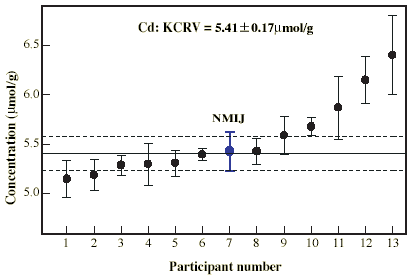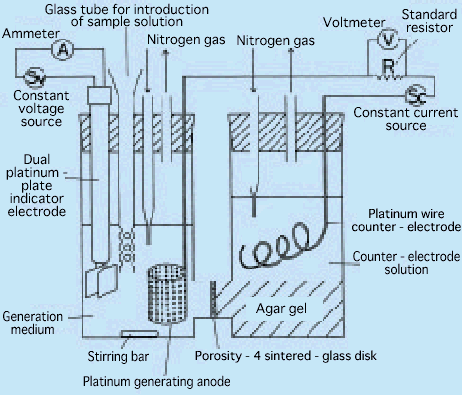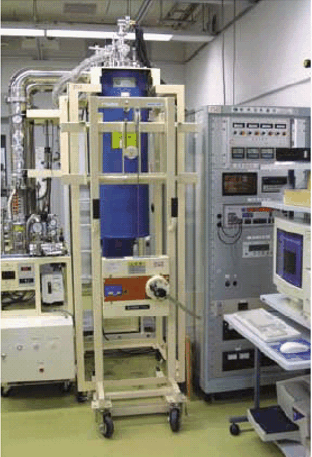- Sorry... We are working on renewing information on this page. Thank you for your patience. -
Standards for the SI Base Units - Amount of Substance
The definition of the mole
The definition of the mole is "the amount of substance of a system which contains as many elementary entities as there are atoms in 0.012 kilogram of carbon 12". NMIJ considers chemical measurements traceable to the SI (such as kg and mol) to be very important, and takes part in many international comparison programs held by the Consultative Committee for Amount of Substance (CCQM) of the International Committee of Weights and Measures (CIPM). The figure on the right shows the results of an international comparison of a determination of cadmium in sediment. NMIJ's measurement proves its excellency, coming extremely close to the key comparison reference value. Measurement methods that can produce results traceable to the SI are called "primary methods of measurement". For example, they are isotope dilution mass spectrometry, coulometry, gravimetry, titrimetry, and freezing point depression. For the international comparison shown in the right figure, we used isotope dilution mass spectrometry.

Coulometric Titration
Coulometric titration is a method based on Faraday's Law. A major advantage of this method is its capability to accurately determine the amount of substance (mole), without any reference materials, by using the standards of electrical quantity, mass and time in addition to Faraday's constant. The method has been used for the determination of the amount of antimony (III) in antimony oxide and ammonium ions in ammonium chloride. More recently, the purity of boric acid, raw material of boron standard solution, was determined by means of acidimetric coulometric titration. Acidimetric coulometric titration is also used to determine hydrochloric concentration, which is an important factor for establishing the pH standard.

Freezing Point Depression
The freezing point depression method is based on the effect that impurities in a sample (high-purity material) depress, or lower, its freezing point. By the precise measurement of freezing point depression of a sample, the total amount of contained impurities can be determined without using reference materials for purity or concentration. The right-hand photo shows an NMIJ-developed adiabatic calorimeter, which can determine purity by the freezing point depression method. Using the calorimeter, NMIJ not only determines purities of raw materials for organic standard solutions and standard gases for environmental measurements but also provides NMIJ certified reference materials.

The definition of the mole:
- The mole is the amount of substance of a system which contains as many elementary entities as there are atoms in 0.012 kilogram of carbon 12; its symbol is "mol".
- When the mole is used, the elementary entities must be specified and may be atoms, molecules, ions, electrons, other particles, or specified groups of such particles. (The 14th CGPM, 1971)
Note:
In this definition, it is understood that unbound atoms of carbon 12, at rest and in their ground state, are referred to.
